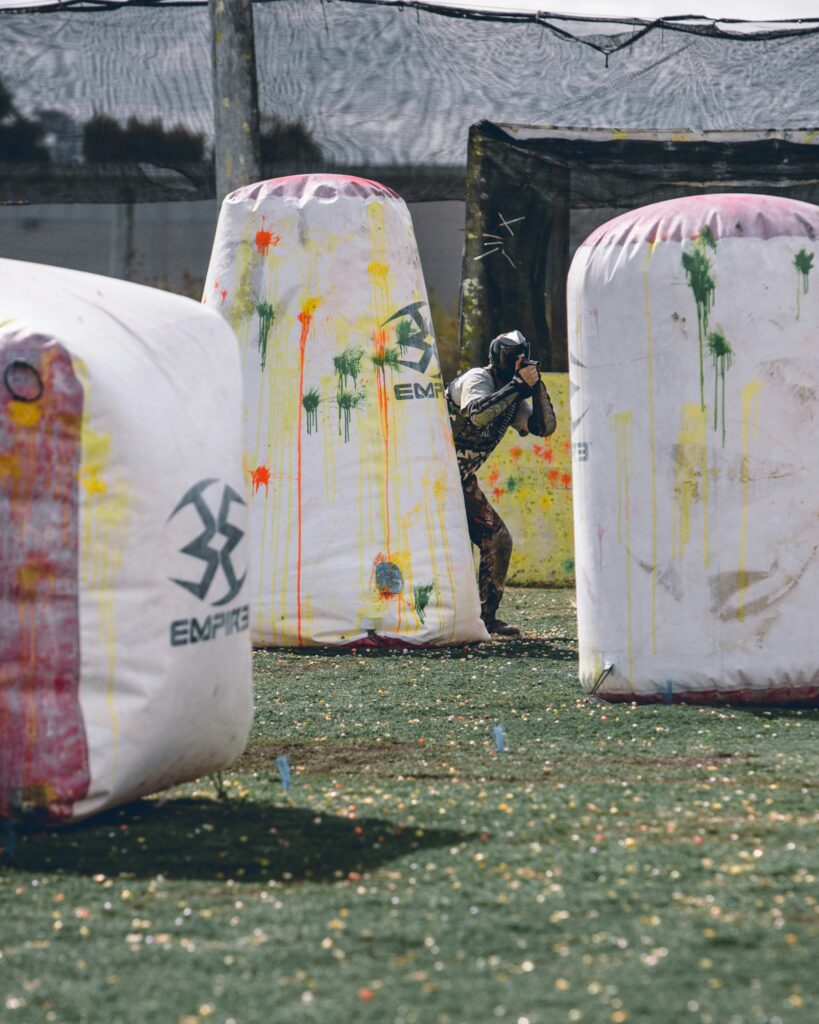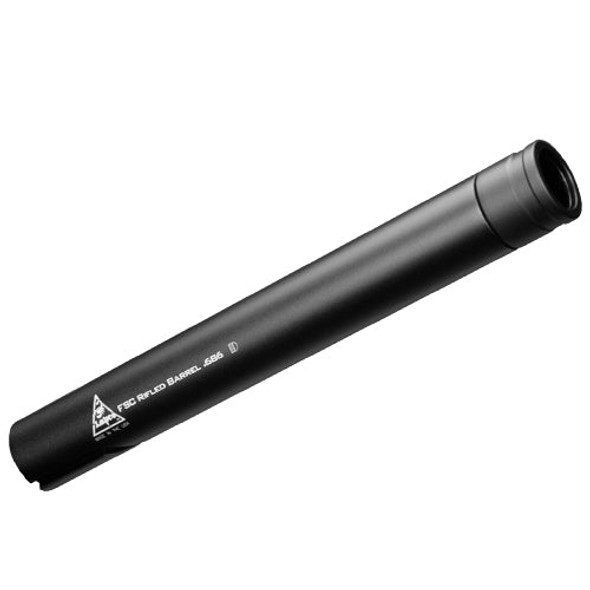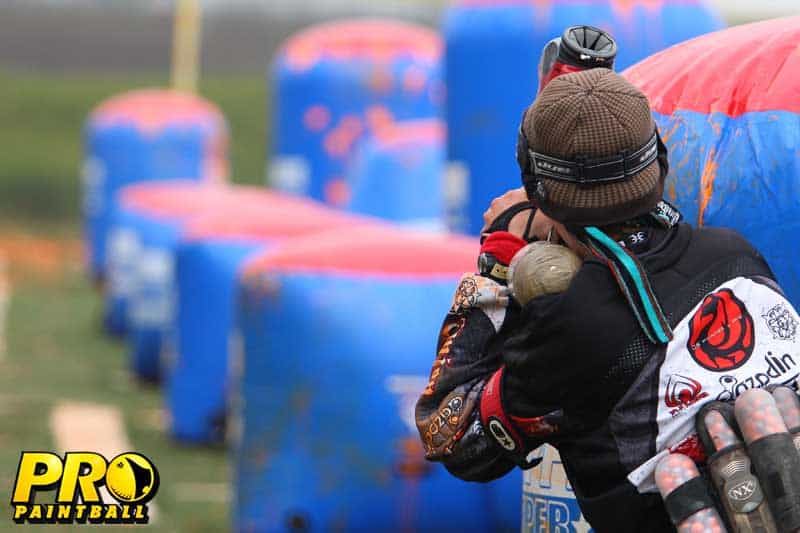Intro to Paintball Gun Ranges
Understanding the range of a paintball gun is as crucial as knowing your own strategy.
The distance a paintball can travel influences your approach to the game.
Range in paintball isn’t just about bragging rights; it’s a fundamental aspect that can dictate the pace and outcome of a game.
Let’s delve into the science and strategy behind paintball gun range, from the mechanics that dictate how far a paintball flies to practical tips for extending your reach on the field.
Factors for Paintball Gun Distance

At its core, the shooting range is influenced by a three critical factors:
- air pressure
- paintball size
- barrel length
Each element plays its unique role in propelling that paintball from your marker to the target.
Air pressure is the driving force. Higher pressure can send paintballs flying further, but there’s a cap to maintain safety and fairness.
Then there’s paintball size. Smaller paintballs can sometimes travel further due to less drag. But the standard size ensures consistency and reliability.
Finally, barrel length can be a game-changer. Too long a barrel might reduce efficiency, finding that sweet spot length-wise can significantly enhance your shot’s range. We recommend 14-16″.
For a great post on long-range guns, read the Best Sniper Paintball Guns
Maximizing Your Paintball Gun’s Shooting Range

To boost your paintball gun’s range without skimping on safety or precision, consider a few game-changing adjustments.
- Upgrade to a longer barrel. This can add some distance to your shots, thanks to improved air efficiency around the paintball.
- Fine-tune your marker’s velocity is key. Adjusting within safe limits, usually under 300 fps, can give you that extra edge. Read below for steps on how to do this.
- Use high-quality paintballs.
Combine these strategies with practice, and you’re looking at a marked improvement in your paintball gun’s range, keeping it fun and competitive.
How to Adjust the Velocity of Your Paintball Gun
Adjusting a paintball marker’s velocity typically involves using a velocity adjustment screw or knob located on the marker itself.
Here’s a general guide on how to adjust the velocity.
- Locate the Adjustment Screw/Knob: Look for the velocity adjustment screw or knob on your paintball marker. It’s usually located near the rear or bottom of the marker.
- Use a Chronograph: To ensure you’re within safe limits and to accurately adjust the velocity, you’ll need a chronograph. This device measures the velocity of paintballs as they are fired from the marker.
- Fire Test Shots: Fire a few test shots through the chronograph to measure the velocity of the paintballs.
- Adjust Velocity: If the velocity is too high, you’ll need to lower it. Turn the adjustment screw or knob counterclockwise to decrease the velocity. If the velocity is too low, turn the screw or knob clockwise to increase it.
- Repeat Test Shots: After making adjustments, fire more test shots through the chronograph to check the new velocity. Continue adjusting until you reach the desired velocity, typically under 300 fps for safety.
- Final Test: Once you’ve adjusted the velocity to your satisfaction, perform a final test to ensure consistency and safety.
- Secure Adjustment: Once you’ve achieved the desired velocity, make sure to secure the adjustment screw or knob to prevent it from changing accidentally during gameplay.
It’s essential to follow any specific instructions provided in your marker’s manual regarding velocity adjustment to ensure proper operation and safety. Additionally, always adhere to field regulations regarding maximum velocity limits.
How Far Does a Paintball Gun Shoot?
On average, a paintball gun can accurately shoot between 80 to 120 feet, with the potential to reach up to 150 feet under ideal conditions. Beyond 100 feet, accuracy drops significantly, making long-distance shots more about luck than skill.
Also Read: The Best Paintball Barrels
Safety Considerations and Range
When it comes to paintball, range isn’t just about hitting your target; it’s also about safety. Knowing the effective range of your paintball gun is key to ensuring everyone has a good time without unnecessary risk.
The general rule is to maintain a minimum distance of 20 feet when firing at someone. This distance helps prevent injuries from close-range impacts, which can be more painful and potentially harmful.
It’s vital to respect field rules, which often specify minimum engagement distances based on the gun’s power and the safety gear in use.
For example, fields catering to players with high-powered markers and comprehensive protective equipment might allow closer engagements. Conversely, casual play areas might enforce longer distances to suit players with less protective gear.
Concluding Paintball Gun Range
Understanding and adhering to these guidelines enhances the game’s safety and enjoyment for everyone involved. It’s all about balancing the thrill of the sport with the well-being of its participants.
Always play responsibly, keeping range and safety at the forefront of your strategy.
Understanding your paintball gun’s range is more than a technicality; it’s a strategic advantage and a safety essential. We’ve covered the mechanics behind paintball ranges, from air pressure and paintball size to barrel length and velocity settings.
These elements combined dictate how far and accurately you can shoot, impacting your gameplay and tactical approach.
Applying this knowledge on the field can significantly enhance your paintball experience. By adjusting your equipment and playing style based on an understanding of range, you can engage opponents more effectively while maintaining safety for yourself and others.
Remember, a well-informed paintballer is not only a better player but also a safer one. So, take this insight back to the field, refine your strategy, and enjoy the game with newfound confidence and respect for the dynamics of paintball range.
Keep Reading: Learn about Compressed Air Tanks
On average, a paintball gun can accurately shoot between 80 to 100 feet, with the potential to reach up to 150 feet under ideal conditions. However, it’s important to temper expectations with reality. Beyond 100 feet, accuracy drops significantly, making long-distance shots more about luck than skill.
No. Pump markers might not shoot as far as their semi-automatic or electronic counterparts.
